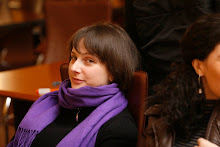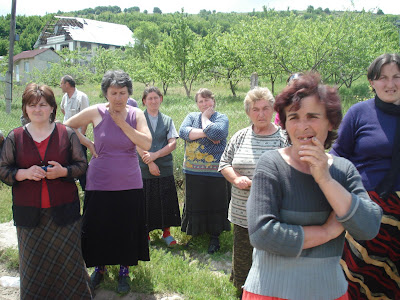Human Emotions spilling over Art Villa Garikula
The contemporary art festival, Fest i Nova, recently hosted the Human Emotion Project (HEP) presented by Georgian artist Irina Gabiani.
 Fest i Nova is a newly launched contemporary art event, held from Aug. 5 to Oct. 25, in the Garikula art villa in the Shida Kartli region. Karaman Kutateladze, founder of the festival, and the Shida Kartli Cultural Heritage Foundation, own the art villa.
Fest i Nova is a newly launched contemporary art event, held from Aug. 5 to Oct. 25, in the Garikula art villa in the Shida Kartli region. Karaman Kutateladze, founder of the festival, and the Shida Kartli Cultural Heritage Foundation, own the art villa.
“I wanted to turn the house into a contemporary art gallery and I suppose I have reached my goal,” Kutateladze said.
The festival also hosts artists from Austria, France, Netherlands, Georgia and the U.S.
“The artists are invited to realize individual projects in the framework of the project. The goal is to create a specific platform to facilitate the exchange of artistic views and stimulate different practices of contemporary art,” reads the summary of the Fest i Nova project.
Gabiani is a Georgian artist living and working in Luxemburg. After studying at the Tbilisi State Academy of Arts, she continued her study at the Amsterdam Gerrit Rietveld Academy. Her major field of interest is human emotions.
Together with her individual works she is involved in a variety of international projects, and the HEP is one of them. The HEP Georgian presentation was held by Gabiani in Garikula.
The HEP, a collection of video art, was created by Alison Williams, a contemporary South African artist.
“HEP 2009 was born out of a voyeuristic need to observe how other artists express themselves on an emotional level and to see the effectiveness of that in a social context via physical exhibitions and an online interaction,” she writes in the project summary.
Collaborating artists found each other on the Art Review Magazine’s Web site in early 2009. Since then the project has been screened in several countries, including Australia, Spain, Portugal, Italy and now Georgia.
Two and three minute films of different foreign artists displayed a big disparity of emotions.
Irina Gabiani has placed two of her films in the project, “The Slaves of the System” and “Samaia or Triamazikamno.”
“Samaia” depicts the moods of an ordinary person: sadness, anger and joy. According to the artist, none of these moods are stable and positive. They turn on each other rapidly and do not give the protagonist a chance to live sensibly.
“You feel in harmony only when you stand apart from all these moods, only in this case do you feel calm and comfortable inside,” the artist said. The three emotions are symbolic and cover many other varieties of moods that a human being has, she added.
Gabiani who usually only employs two shades – black and white – assumes that there are three energies in the universe – positive, negative and neutral. She became interested in the “essence of life” and indulged in physics. Science gave her a solid basis for her view of life. Electron as minus, proton as plus and neutron as neutralizing are the essences of the universe, she ponders.
Although people perceive things to be either black or white, Gabiani said, she on the other hand likes to be an impartial observer.
Gabiani tries to bring up things from everyday life in her work to make people perceive themselves as a whole, as part of the universe instead of being involved in the insensate triviality of life.
“So many things are happening around us, that we even cannot think about and the world is so complex that if we realize it, we would look at the events and facts around us in a completely different way,” she said.
Her later works, done also in black and white, depict atoms, micro and macro elements. She attempts to show the viewer the whole notion of the world around us, often leaving behind our minds.
Anna Chichinadze
18.09.2009
 Fest i Nova is a newly launched contemporary art event, held from Aug. 5 to Oct. 25, in the Garikula art villa in the Shida Kartli region. Karaman Kutateladze, founder of the festival, and the Shida Kartli Cultural Heritage Foundation, own the art villa.
Fest i Nova is a newly launched contemporary art event, held from Aug. 5 to Oct. 25, in the Garikula art villa in the Shida Kartli region. Karaman Kutateladze, founder of the festival, and the Shida Kartli Cultural Heritage Foundation, own the art villa.“I wanted to turn the house into a contemporary art gallery and I suppose I have reached my goal,” Kutateladze said.
The festival also hosts artists from Austria, France, Netherlands, Georgia and the U.S.
“The artists are invited to realize individual projects in the framework of the project. The goal is to create a specific platform to facilitate the exchange of artistic views and stimulate different practices of contemporary art,” reads the summary of the Fest i Nova project.
Gabiani is a Georgian artist living and working in Luxemburg. After studying at the Tbilisi State Academy of Arts, she continued her study at the Amsterdam Gerrit Rietveld Academy. Her major field of interest is human emotions.
Together with her individual works she is involved in a variety of international projects, and the HEP is one of them. The HEP Georgian presentation was held by Gabiani in Garikula.
The HEP, a collection of video art, was created by Alison Williams, a contemporary South African artist.
“HEP 2009 was born out of a voyeuristic need to observe how other artists express themselves on an emotional level and to see the effectiveness of that in a social context via physical exhibitions and an online interaction,” she writes in the project summary.
Collaborating artists found each other on the Art Review Magazine’s Web site in early 2009. Since then the project has been screened in several countries, including Australia, Spain, Portugal, Italy and now Georgia.
Two and three minute films of different foreign artists displayed a big disparity of emotions.
Irina Gabiani has placed two of her films in the project, “The Slaves of the System” and “Samaia or Triamazikamno.”
“Samaia” depicts the moods of an ordinary person: sadness, anger and joy. According to the artist, none of these moods are stable and positive. They turn on each other rapidly and do not give the protagonist a chance to live sensibly.
“You feel in harmony only when you stand apart from all these moods, only in this case do you feel calm and comfortable inside,” the artist said. The three emotions are symbolic and cover many other varieties of moods that a human being has, she added.
Gabiani who usually only employs two shades – black and white – assumes that there are three energies in the universe – positive, negative and neutral. She became interested in the “essence of life” and indulged in physics. Science gave her a solid basis for her view of life. Electron as minus, proton as plus and neutron as neutralizing are the essences of the universe, she ponders.
Although people perceive things to be either black or white, Gabiani said, she on the other hand likes to be an impartial observer.
Gabiani tries to bring up things from everyday life in her work to make people perceive themselves as a whole, as part of the universe instead of being involved in the insensate triviality of life.
“So many things are happening around us, that we even cannot think about and the world is so complex that if we realize it, we would look at the events and facts around us in a completely different way,” she said.
Her later works, done also in black and white, depict atoms, micro and macro elements. She attempts to show the viewer the whole notion of the world around us, often leaving behind our minds.
Anna Chichinadze
18.09.2009







 “We are not killing animals, we just make injections to euthanize old and sick dogs, others we vaccinate, sterilize and let out into the streets,” he said.
“We are not killing animals, we just make injections to euthanize old and sick dogs, others we vaccinate, sterilize and let out into the streets,” he said.
 Amonashvili is leading protection monitoring program throughout the twenty five buffer zone villages, which began from January 2009. She spends five or seven days in the villages and knows almost everyone by name, their problems and struggles.
Amonashvili is leading protection monitoring program throughout the twenty five buffer zone villages, which began from January 2009. She spends five or seven days in the villages and knows almost everyone by name, their problems and struggles.











 Intense colors of
Intense colors of 





